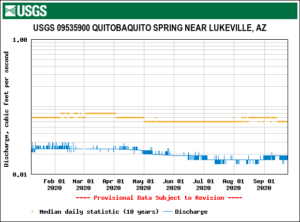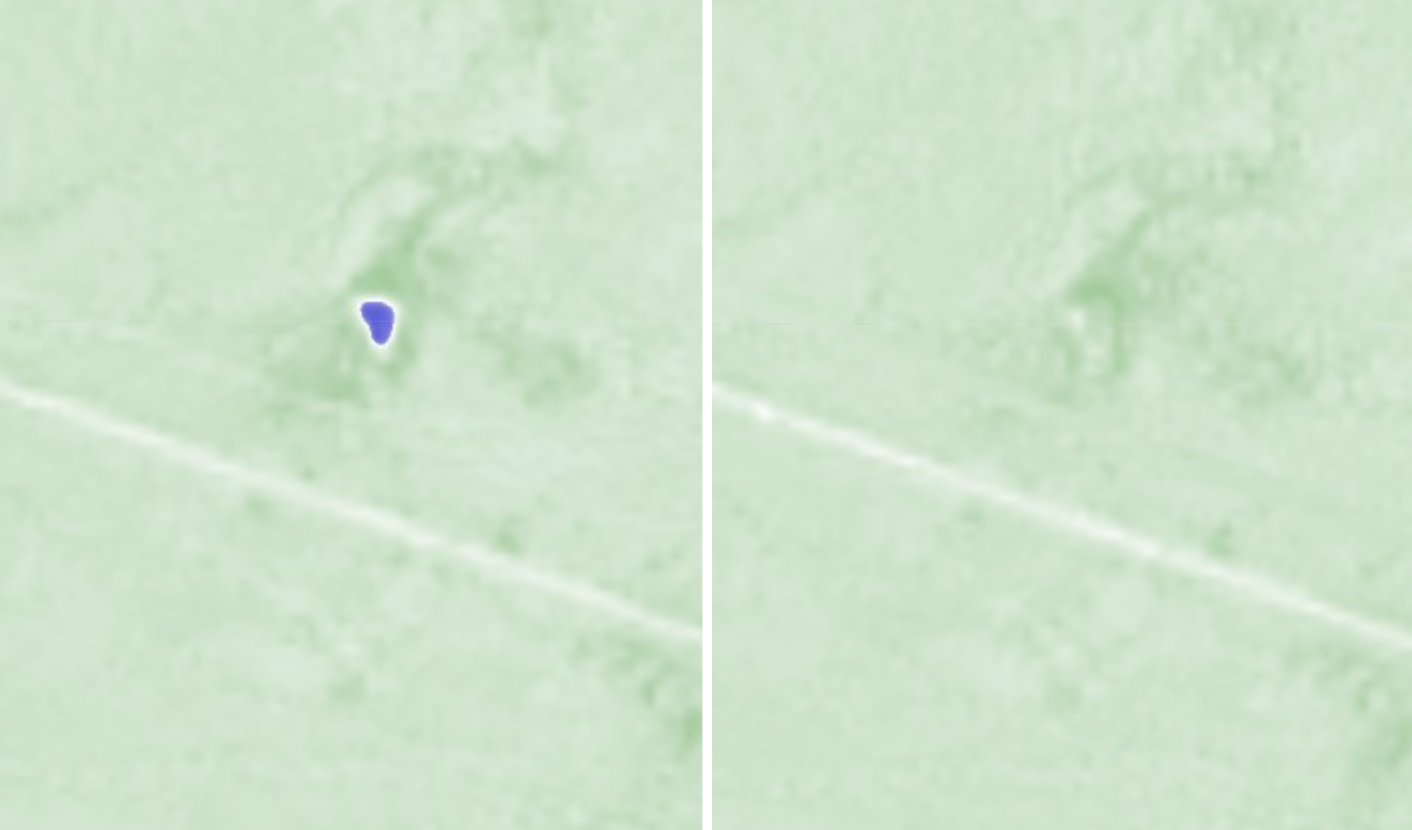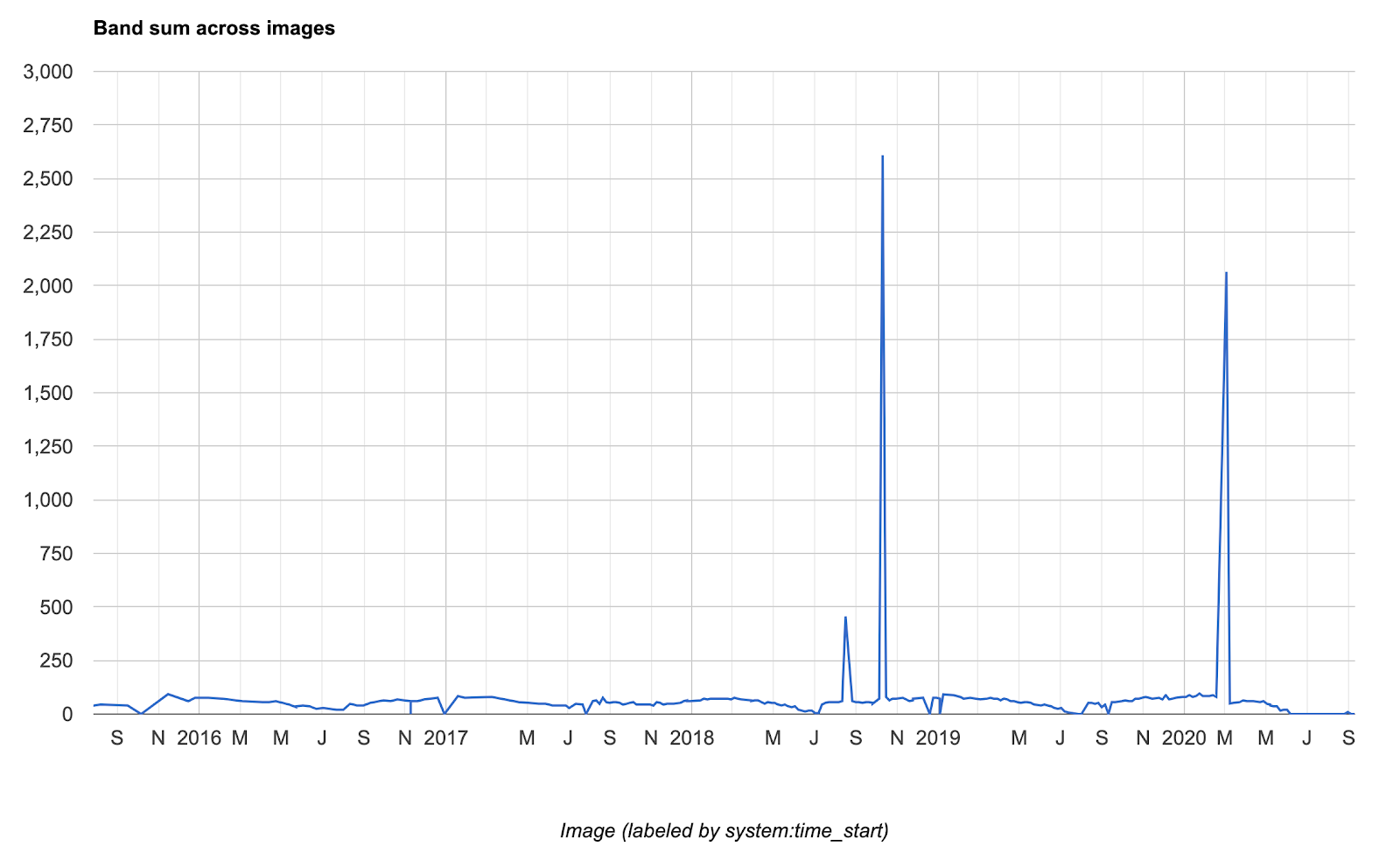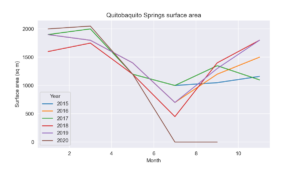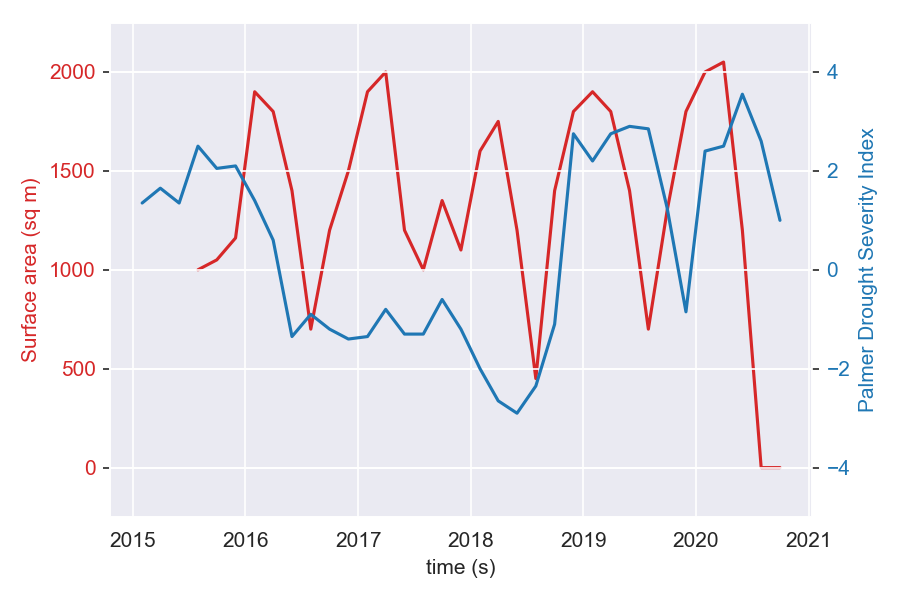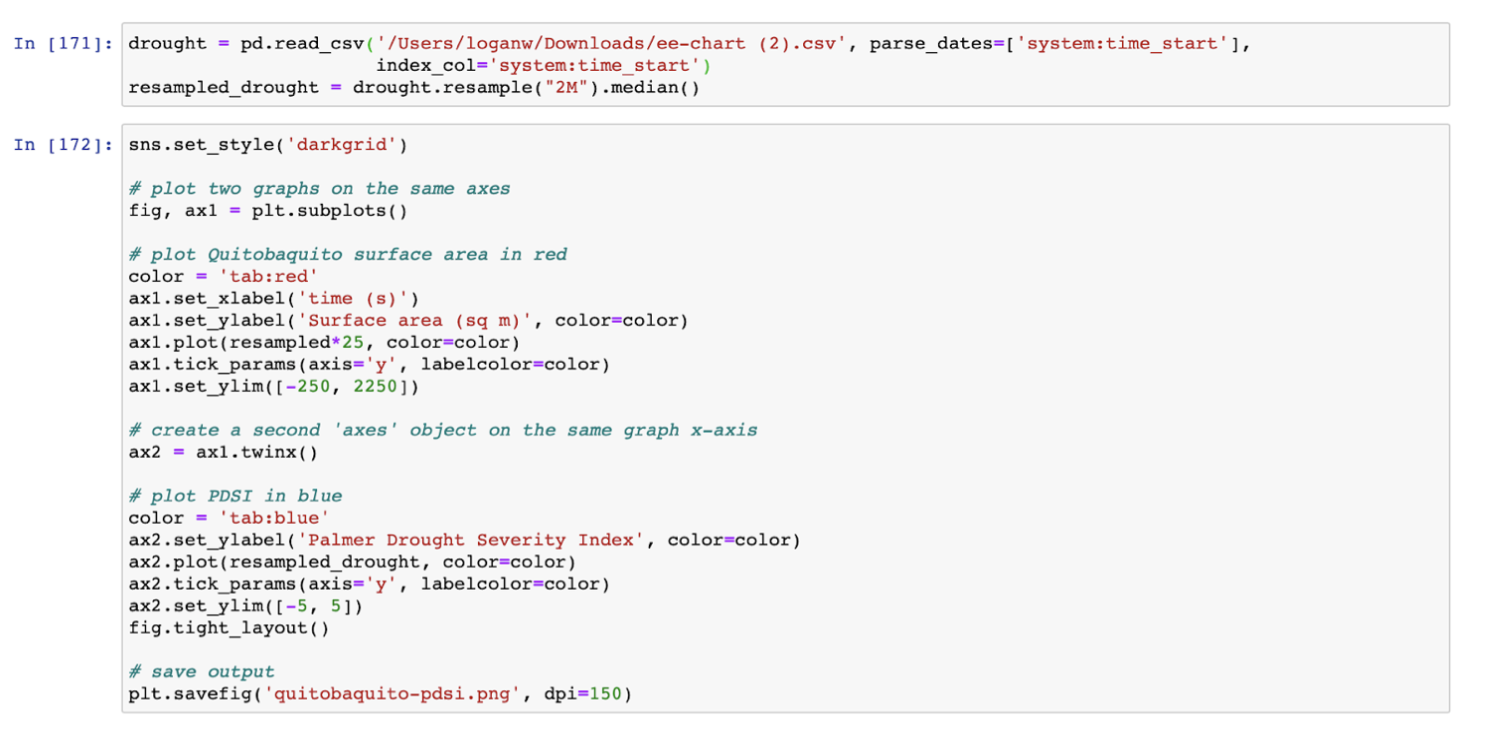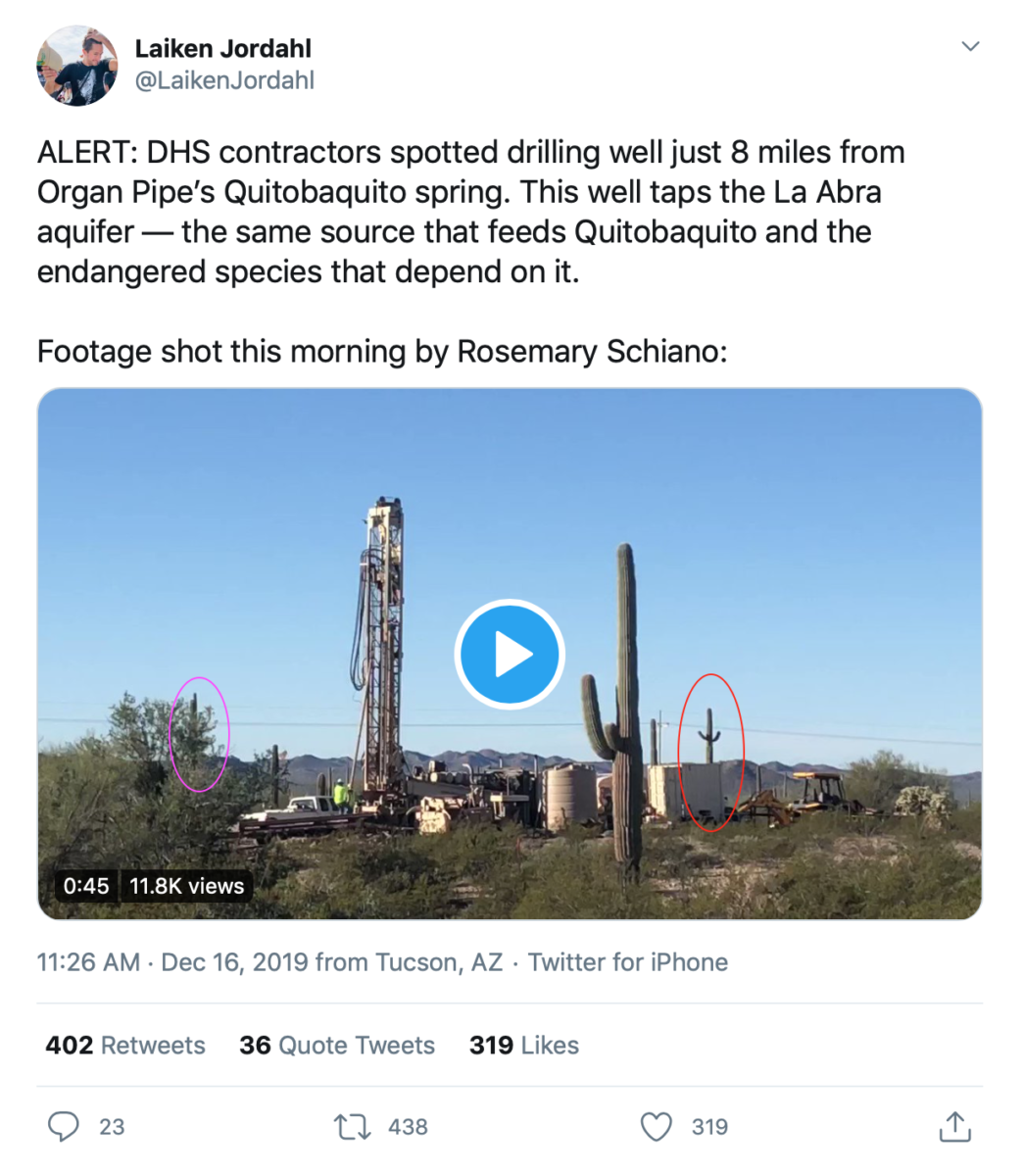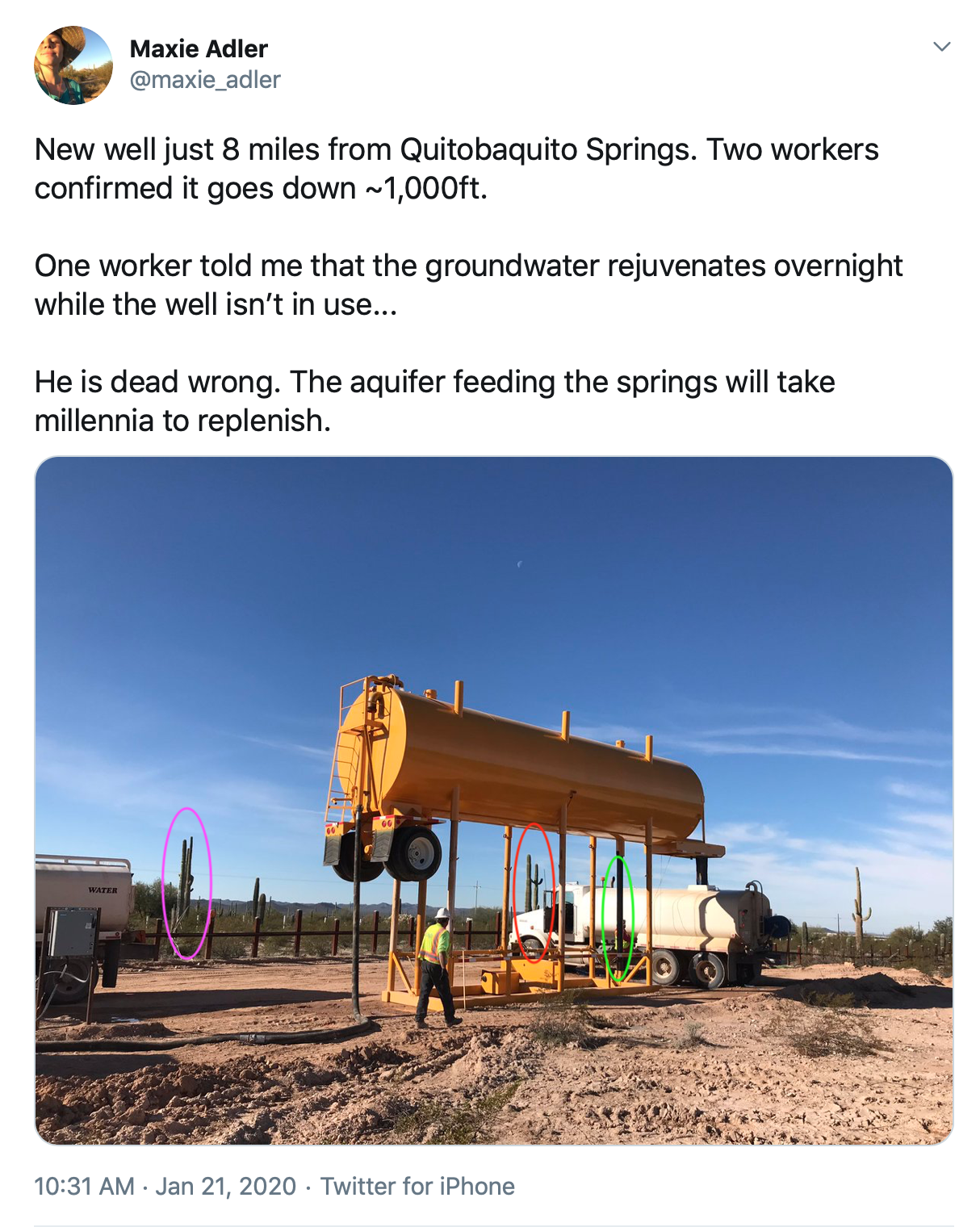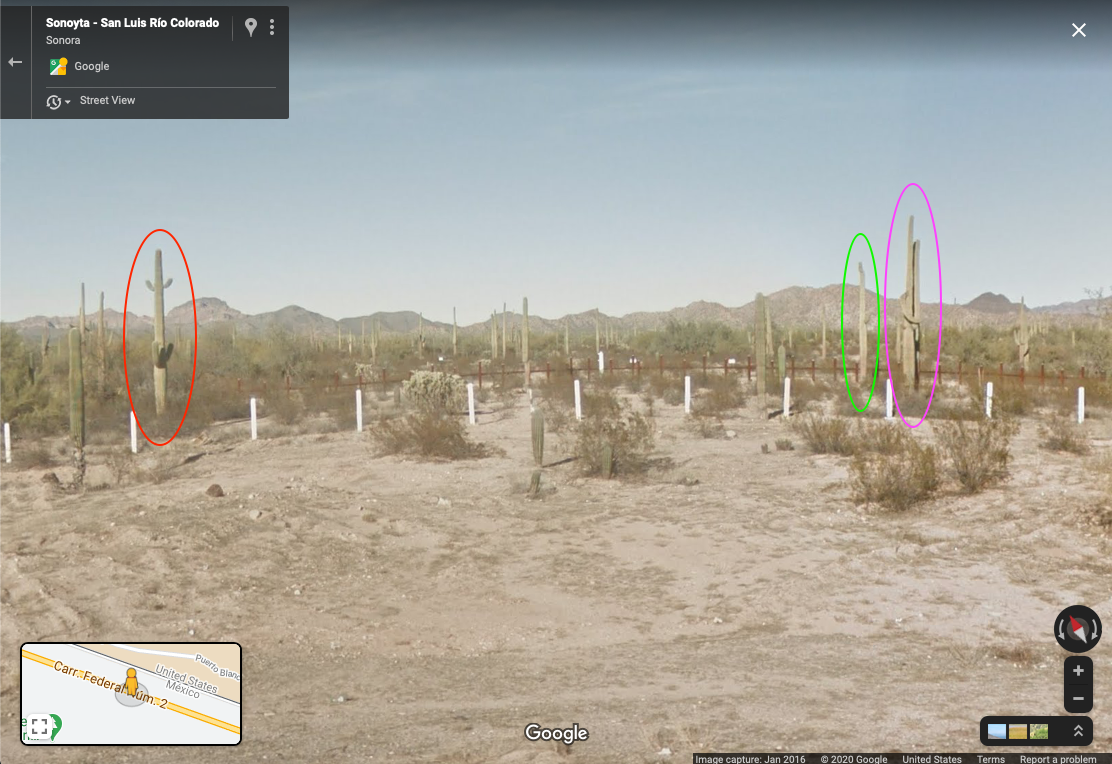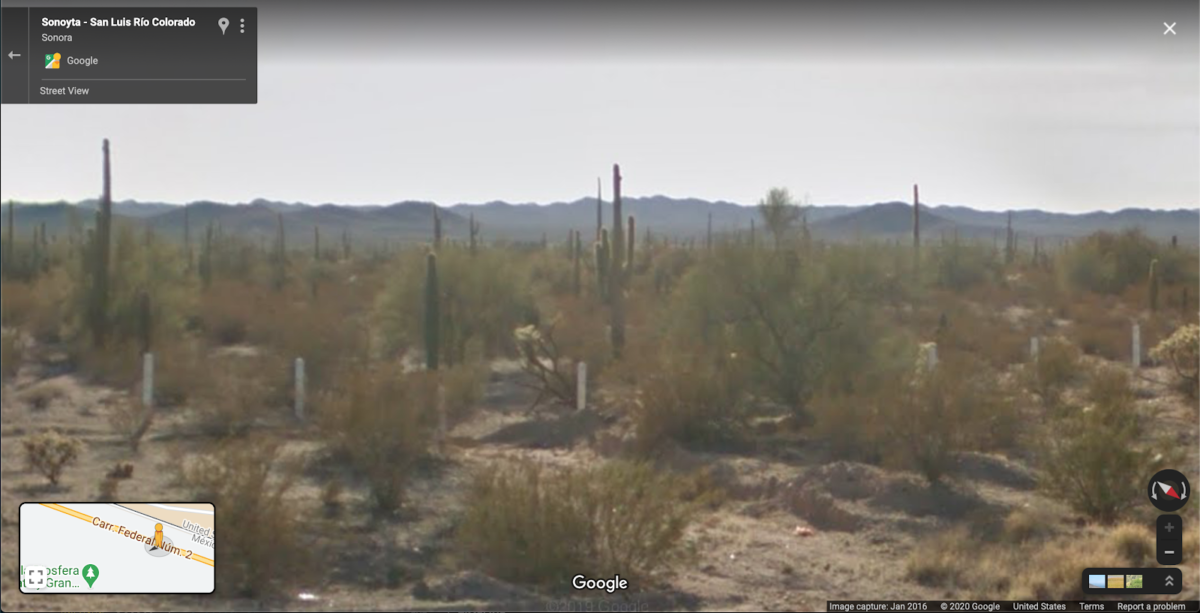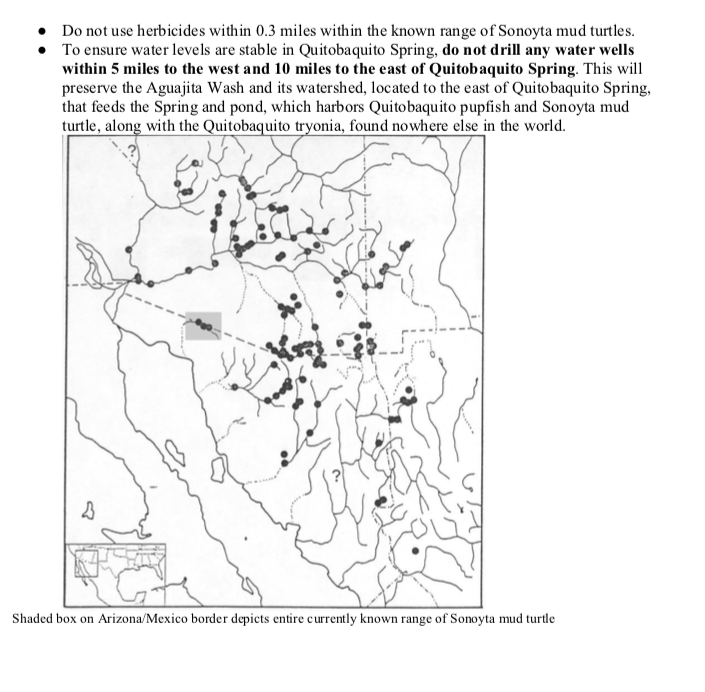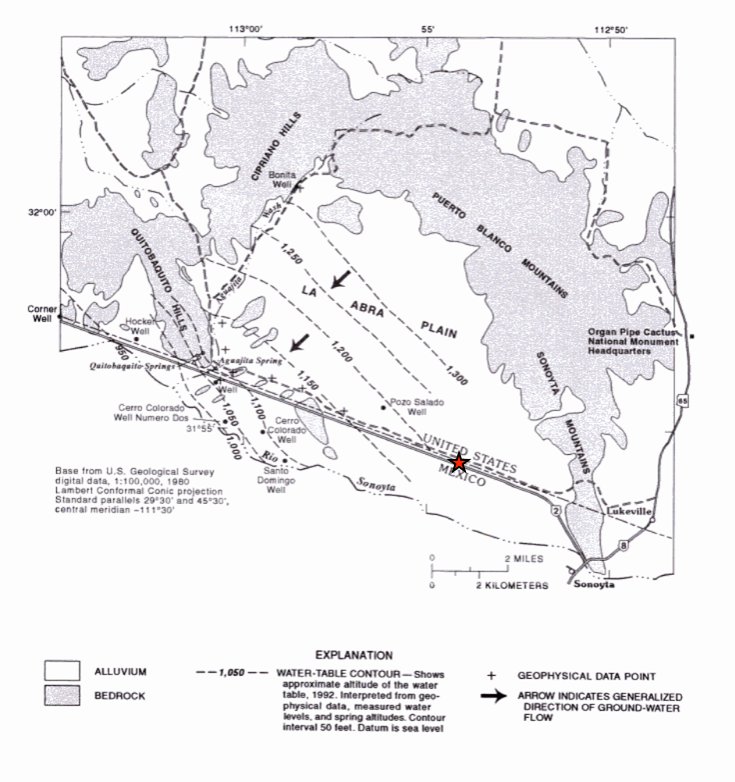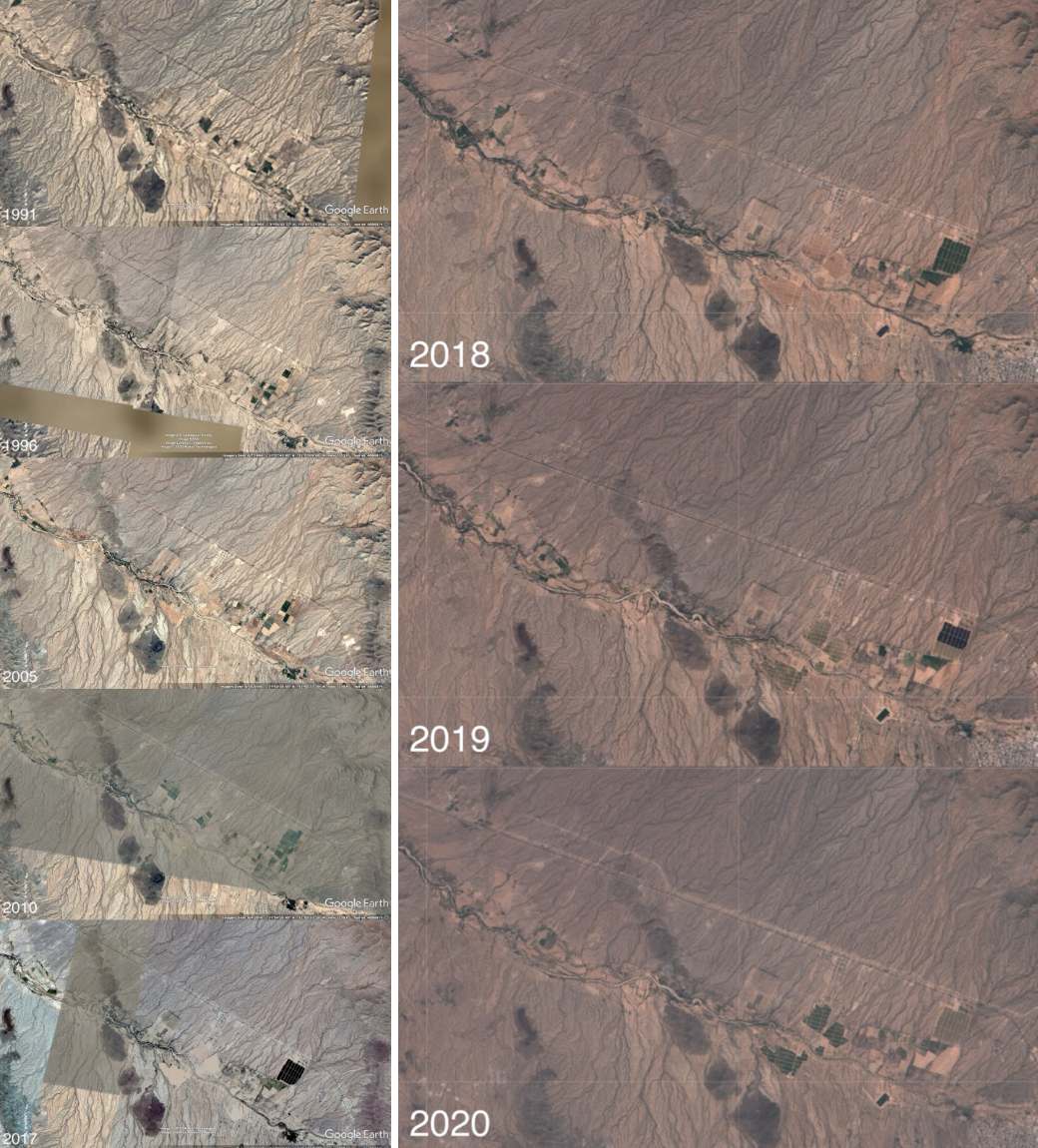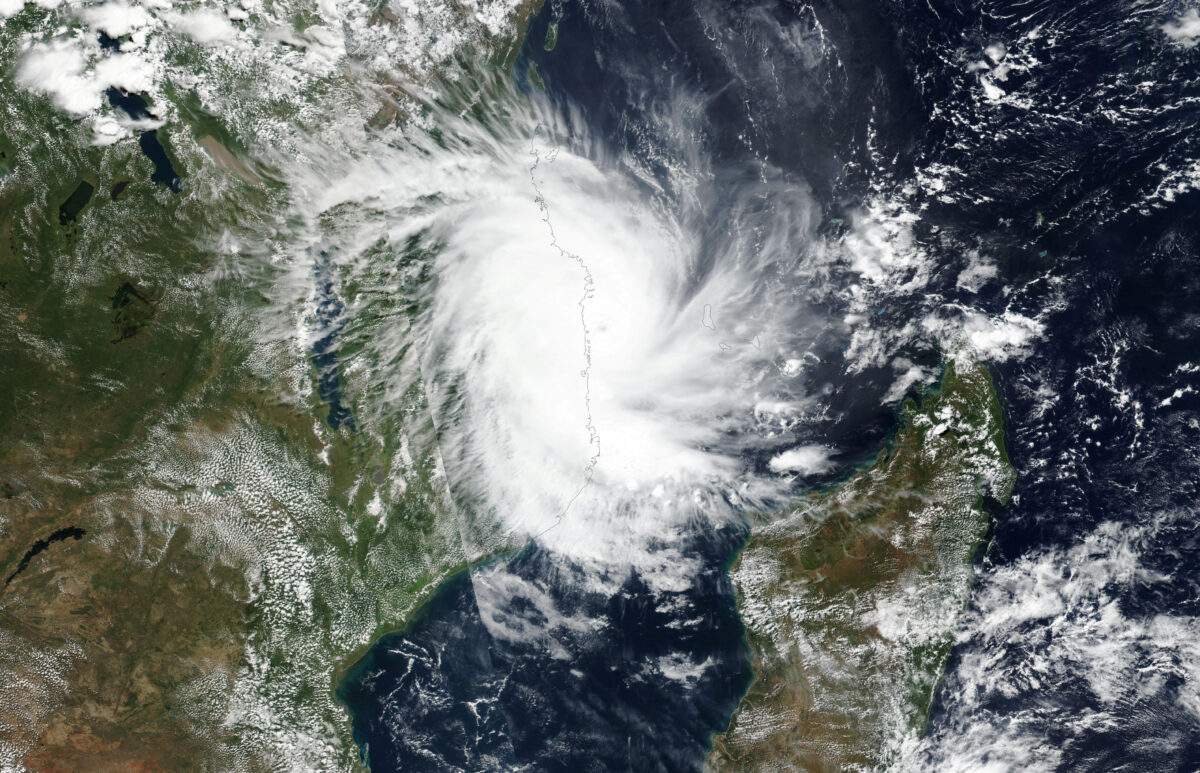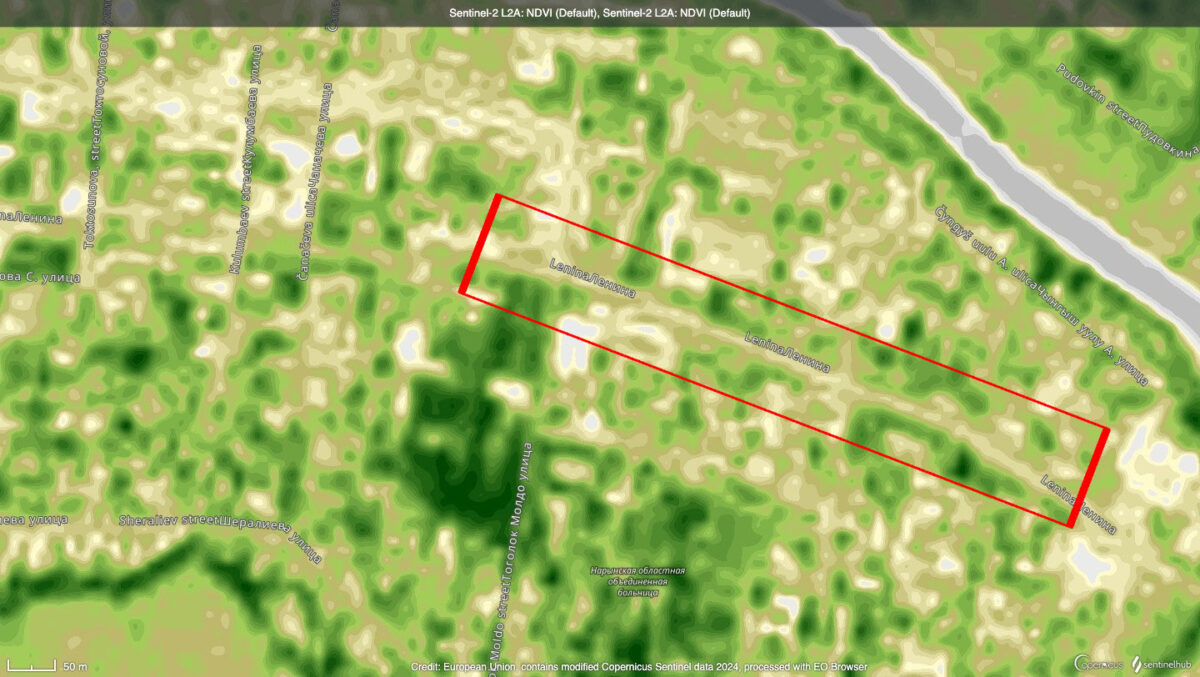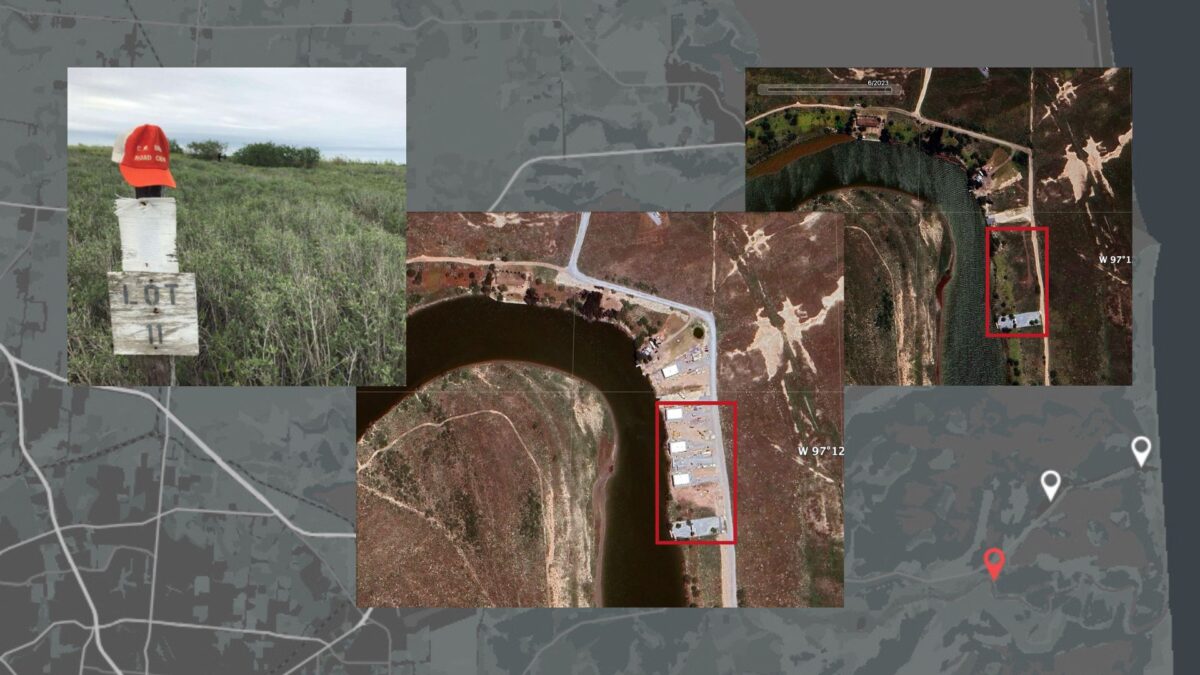The Disappearance of Quitobaquito Springs: Tracking Hydrologic Change with Google Earth Engine
Written by Logan Williams
In the remote Sonoran desert along the US-Mexico border, water is extremely scarce. Desert-adapted plants and animals rely on rare springs for survival, and many unique habitats have evolved around some of the most isolated sources of water.
Quitobaquito Springs in Pima County, Arizona, is one of these life sustaining oases. The Quitobaquito Pupfish and Sonoyta mud turtle, which are protected under the US Endangered Species Act, depend on it. So too do desert mammals and millions of migratory birds that travel the North American Flyway.
Yet in the summer of 2020, water levels in the pond fed by Quitobaquito Springs began declining precipitously. Environmental advocates and members of the Tohono O’odham nation, for whom the springs are a sacred site, correlate this with the construction of President Trump’s border wall which is being built nearby under a waiver from standard environmental regulations.
In addition to the persistent rumbling of heavy machinery and truck traffic, wall construction requires 84,000 gallons of water per day for concrete and dust mitigation. Activists fear the pumping of water from the same ground sources that likely feed the springs could be reducing water levels there. Social media images posted earlier this year, meanwhile, appear to show a well being explored and tapped by border wall contractors just a few miles from the springs.
Quitobaquito Springs in early Fall 2017 and again in late Summer 2020, showing the dramatic decline in water levels. Other before and after images have been juxtaposed by local Arizona media. Using open Sentinel-2 imagery, this decline can be quantified and compared to previous drought years.
But just how unprecedented is the recent loss of water at Quitobaquito Springs? The flow of water has been slowly declining since the 1980s, according to data held by the US Geological Survey. Could other factors such as drought or agricultural usage provide a simpler explanation? Establishing a direct causal relationship between ongoing construction work and a system as interconnected and complex as an aquifer is also extremely difficult.
Those responsible for the border wall construction project also deny impacting Quitobaquito Springs. When contacted by Bellingcat, US Customs and Border Protection (CBP) said “monsoonal and leaks with the existing liner of the pond” were more likely behind the falling water levels.
Fortunately, open source investigative methods can provide us with valuable information to help address these questions and hypotheses. Not only can we measure the loss of water in the pond from satellite imagery, we can also use other public data sets to evaluate explanations such as drought and agricultural water usage.
As we will explain below, the data shows that the decline is rapid and without recent precedent, that drought is not a likely explanation, and that there has not been a clear expansion of agriculture on the Mexican side of the border in recent years. We have also been able to geolocate images of what appears to be a well tapped by border wall contractors that could be impacting the hydrology of the area.
Tracking the loss of Quitobaquito Springs with Sentinel-2 imagery
The US Geological Survey installed an electronic flow gauge on Quitobaquito Springs in January 2020. Prior to this, occasional manual measurements were taken to assess the flow of water to the springs, establishing the baseline in the graphic below.
The new gauge shows that the flow rate has generally been declining since it was installed, to a minimum this summer of less than seven gallons per minute. This is down from over 11 gallons per minute when the gauge was installed, and from an average of 30 gallons per minute over the last 10 years when compared with the manual measurements previously recorded. Unfortunately, because this modern gauge was installed so recently, it does not make it possible to see how rapidly these changes might have occurred.
However, with Sentinel-2 satellite imagery, we can measure the surface area of the springs and see how that has changed over a longer period of time. Sentinel-2 captures 10 meter resolution imagery, which means that each pixel in an image represents approximately 10m x 10m of the Earth. It is often thought that this is too low a resolution to be useful for understanding small changes. But that is not always the case.
One of the biggest advantages of Sentinel-2 is that it captures images at many wavelengths of light, including those beyond the range of human eyesight. With the near-infrared (NIR) band, we can compute an image that highlights surface water, known as the Normalized Difference Water Index, or NDWI. For each pixel in an image, the NDWI value is equal to (Green – NIR) / (Green + NIR). When the NDWI value is greater than a threshold, typically between 0 and 0.3, we know that that pixel represents water. This computed product allows even a pond as small as Quitobaquito (60m x 40m) to be monitored.
On the left, Sentinel-2 NDWI image for May 2019. On the right, NDWI image for September 2020, showing the almost complete loss of detectable surface water. (Source: Sentinel-Hub Playground)
To analyze this data over time, it is very helpful to use Google Earth Engine, a free tool for accessing, filtering, and analyzing portions of Sentinel-2 imagery and other open datasets. In Google Earth Engine, this can be done by filtering the ‘COPERNICUS/S2’ collection, computing the NDWI image, and thresholding it to decide which pixels represent water. Then, the pixels that represent water in each image are counted and graphed over time.
The example script to carry out this analysis can be seen below:
Map.setCenter(-113.020683, 31.942751); Map.setZoom(15); // create a geometry buffer around the spring to analyze var springs = ee.Geometry.Point(-113.020683, 31.942751); var buffer = springs.buffer(100); // Find Sentinel-2 data since 2015 var collection = ee .ImageCollection("COPERNICUS/S2") .filterBounds(springs) .filterDate("2015-01-01", "2020-09-10") .filter(ee.Filter.lt("CLOUDY_PIXEL_PERCENTAGE", 30)); // Compute the NDWI image from bands 3 and 8 var ndwi = collection.map(function (image) { return image .normalizedDifference(["B3", "B8"]) .copyProperties(image, ["system:time_start"]); }); // Detect surface water by thresholding at 0 var thresholded = ndwi.map(function (image) { return image.gt(0).copyProperties(image, ["system:time_start"]); }); // Generate a chart of the number of detected surface water pixels over time print(ui.Chart.image.series(thresholded, buffer, ee.Reducer.sum(), 5));
Running this program in Google Earth Engine will produce a graph that shows a clear seasonal trend. However, this graph has some obvious shortcomings. When the area of interest is in the shadow of a cloud, for example, the computed NDWI values are incorrect, resulting in erroneously high number of water pixels. Additionally, it is hard to see if there is a longer, multi-year trend in addition to the seasonal variation.
To improve this, we can take the median value for every two months by using a Python script. This two month window is sufficient to avoid any periods of missing or invalid data. Additionally, we can stack each year on top of each other, to make the difference between 2020 and other years more clear. This produces the following chart, which shows a clear and dramatic decline in the surface water at Quitobaquito Springs in the summer of 2020.
In the complete record of Sentinel-2 imagery since 2015, a decline of this size is unprecedented. Furthermore, the decline occurred quite fast: as late as May 2020, the pond appeared to be a typical size.
The Python code to perform this year-over-year stacking is included below for reproducibility, and in a Github repository.
Comparing Quitobaquito fluctuations with drought patterns
We compared the Quitobaquito surface area with observed weather conditions to see how fluctuations in water levels compared to drought patterns. To do this, we looked at the Palmer Drought Severity Index, a standard measure of drought conditions that uses temperature and precipitation over multiple timescales to estimate dryness. This metric is also available in Google Earth Engine, and we can analyze it in a very similar way to the Sentinel-2 imagery.
var drought = ee .ImageCollection("GRIDMET/DROUGHT") .filterBounds(springs) .filterDate("2015-01-01", "2020-09-10"); print( ui.Chart.image.series(drought.select("pdsi"), buffer, ee.Reducer.mean(), 5) );
With this metric, we can see that while there are drier conditions that began in Spring 2020, these conditions are fairly typical of the previous five years. In contrast, the conditions at Quitobaquito Springs are unprecedented, suggesting that short and medium term drought conditions are not a likely cause of the drying. Additionally, the rapid loss of water from the pond, suggests that long-term changes are a less likely explanation as well.
A plot of the Quitobaquito Pool surface area (in red) and the Palmer Drought Severity Index (in blue) from 2015 to 2020.
The Python script for graphing these two variables together is included below, and accessible in the Github repository.
A scatter plot of these two variables further confirms the lack of correlation. When there is a drought (the left hand side of the graph), the observed surface area of the pond does not appear to be lower than when there is a surplus of precipitation (the right hand side of the graph.)
Locating US border wall construction and well drilling activities
On December 16, 2019, Twitter user and anti-border wall activist, @LaikenJordahl, posted a video showing well drilling activities at a claimed location just eight miles to the east of Quitobaquito Springs. Another video published by a separate activist one month later appeared to show an operative well at the same site. The location of the posts can be verified by looking at the nearby mountain range and several distinctive saguaro cacti in Google Street View imagery on the Mexican side of the border. While saguaros can look very similar, the presence of the mountains in the background and the three distinctive cacti is sufficient to validate the accuracy of the stated location.
Well drilling activities in December 2019, from @LaikenJordahl on Twitter. Two saguaros are circled in red and purple.
Operative well in January 2020, from @maxie_adler on Twitter. The same two saguaros are circled, as well as a third in green.
Google Street View imagery with the same three cacti visible, from the Mexican side of the border.
Google Street View imagery at the verified location with the same mountain range visible as in the video of well drilling.
As stated previously, this location is about eight miles east of Quitobaquito Springs. Although outside the five mile radius imposed by the Department of Homeland Security, this well would appear to ignore the US Fish and Wildlife Service’s apparent conservation recommendations for border wall construction, requested in 2019. These recommendations (screenshot below) state “do not drill any water wells” within five miles to the west and 10 miles to the east of Quitobaquito Springs.
Excerpt from US Fish and Wildlife Service’s 2019 Conservation Recommendations for the Proposed Border Infrastructure Projects in Pima and Cochise Counties, Arizona
When contacted by Bellingcat, however, CBP stated that it had determined, in coordination with the National Park Service (NPS) and U.S. Fish and Wildlife Service, that the use of groundwater would only be restricted to five miles either side of Quitobaquito Springs for new border wall system construction.
In a statement, CBP said: “Based on this recommendation, there have been no use of existing groundwater wells or drilling of any new wells within five miles of either side” of the springs. It was not clear if the U.S. Fish and Wildlife Service had altered its previously published requested recommendations.
The CBP statement also said it was committed to environmental stewardship and that it was monitoring the situation at Quitobaquito Springs, before adding: “There is much evidence that the drop in water levels at the springs is more related to the lack of important monsoonal rainfall and leaks with the existing liner of the pond.”
This explanation would seem to conflict with the drought pattern analysis detailed above.
Further analysis also seems to suggest that the pictured well could still be negatively impacting the hydrology of the area even if it was located outside the five mile distance either side of the springs cited by CBP.
We mapped the well photographed above onto a 1996 hydrogeologic report prepared by the US Geological Survey to try and further understand its potential hydrologic context. The water table underneath the well is above 1,200 feet in elevation, significantly uphill from the water table at Quitobaquito Springs, which is at about 1,050 feet elevation.
As groundwater flows downhill, this means that withdrawals from the border wall construction well could be removing water that would otherwise be flowing towards Quitobaquito Springs.
Identified construction well indicated by red star. Excerpted from Hydrogeology of the Quitobaquito Springs and La Abra Plain area.
Construction activities themselves could be having even more direct impacts on the Quitobaquito pool as well. The pool is impounded with a clay liner, which some suspect may have been damaged by vibrations from nearby construction activity and traffic. While this is difficult to show conclusively, trucks and heavy machinery driving and working along the border road just 150 feet from Quitobaquito pond are well documented. In many cases, this heavy traffic appears to exceed the 10mph speed limit claimed by the Department of Homeland Security.
In response to claims of constructor vehicles exceeding the 10 mph speed limit, CBP said in its statement that the U.S. Army Corps of Engineers, which awards contracts for border wall construction, “CBP, and NPS have been coordinating closely to ensure speed limits for construction vehicles are adhered to in all areas of the project to include in the vicinity of Quitobaquito Springs and on access routes and major roadways leading to and from the project area.”
Observing changes in agricultural use along Rio Sonoyta
Another possible explanation for declining groundwater levels is agricultural usage on the Mexican side of the US-Mexico border. Using aerial imagery from Sentinel-2 and Google Earth sources, we can observe that agricultural cultivation in this area has been variable but relatively consistent over the past 28 years. While fields are cycled in and out of cultivation, we do not observe any new development of agricultural areas. Using Sentinel imagery we can further observe that the conditions have been especially static for the previous three years.
Images from Google Earth (1991-2017) and Sentinel-2 (2018-2020) showing agricultural activities along the Sonoyta River in Mexico.
The 1996 hydrologic report referenced above also indicates that there is some degree of natural separation between the Rio Sonoyta area south of the border and the system that immediately feeds Quitobaquito Springs. However, it further notes that the two are likely to be connected in some way, and that agricultural water consumption is likely pumping more water from the aquifer than can be replenished by rainfall. These long-term overdrafts certainly have negative consequences for the hydrology of the area, but their multi-decade nature is at odds with the rapid change at Quitobaquito Springs.
It is exactly because the changes at Quitobaquito are happening so rapidly that conservation advocates are so concerned. Using open source intelligence methods, we have demonstrated how the speed and extent of these changes can be quantified and compared with historic precedent.
This analysis also shows that a dramatic decrease in water levels at Quitobaquito began just as border wall construction intensified in the area, sped along by a waiver of normal environmental regulations.
While establishing a direct causal relationship in a system as interconnected as an aquifer is extremely difficult, there is no question that the loss of Quitobaquito Springs puts several endangered species on the verge of extinction and will have long-term consequences for all inhabitants of this desert region.

